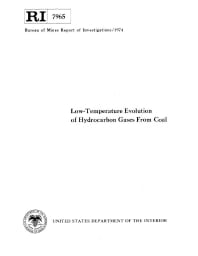Mining Publication: Low-Temperature Evolution of Hydrocarbon Gases From Coal
Original creation date: January 1974
Authors: AG Kim
NIOSHTIC2 Number: 10000608
Pittsburgh, PA: U.S. Department of the Interior, Bureau of Mines, RI 7965, 1974 Jan; :1-23
Hydrocarbon gases, primarily methane but also the c2 through c5 paraffins, the c2 and c3 olefins, and possibly the c4 and c5 olefins, are byproducts of coal formation. Although it is generally believed that coal formation occurred at temperatures below 200 deg C, most experimental work on gas formation from coal has been performed at temperatures between 200 deg and 1,000 deg C. The objective of this Bureau of Mines experiment was to determine if observable changes in the gases from coal could be produced at temperatures below 200 deg C in relatively short periods of time. The experiment involved heating coal samples from six coalbeds at constant temperatures and analyzing evolved gases. The composition of the gases at three temperatures was compared. At 35 deg C, over 99 pct of the gas is methane; at 125 deg and 150 deg C, methane constitutes approximately half of the hydrocarbon gas. Isobutane and pentane are the predominant higher hydrocarbons at temperatures between 100 deg and 150 deg C.

NIOSHTIC2 Number: 10000608
Pittsburgh, PA: U.S. Department of the Interior, Bureau of Mines, RI 7965, 1974 Jan; :1-23
- Assessing the Methane Hazard of Gassy Coals in Storage Silos
- Measuring the Gas Content of Coal: A Review
- Methane and Dust Control by Water Infusion: Pittsburgh Coalbed (Fairview, W. Va.)
- Methane Diffusion Parameters for Sized Coal Particles: A Measuring Apparatus and Some Preliminary Results
- Methane Emissions from Gassy Coals in Storage Silos
- Problems Facing Coal Mining and Gas Production in the Hartshorne Coalbeds of the Western Arkoma Basin, OK
- Removing Methane (Degasification) from the Pocahontas No. 4 Coalbed in Southern West Virginia
- Reservoir Engineering Considerations for Coal Seam Degasification and Methane Control in Underground Mines
- A Review of the Mechanisms of Gas Outbursts in Coal
- Sorption Investigations of Methane on Coal